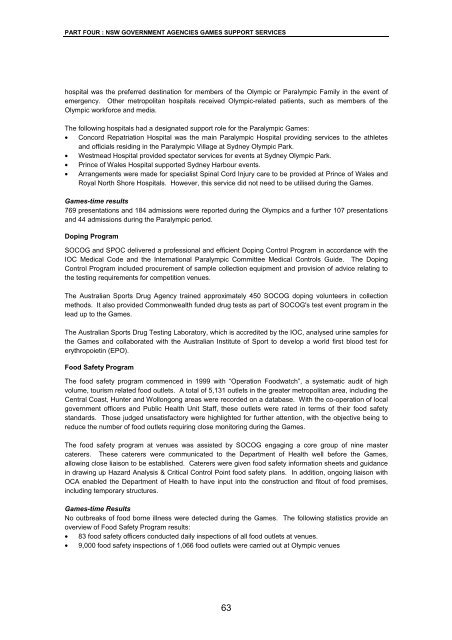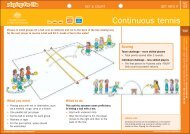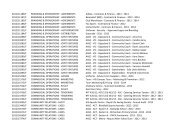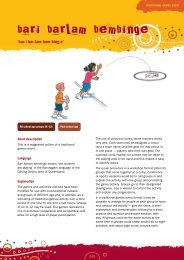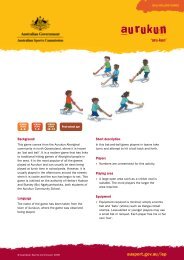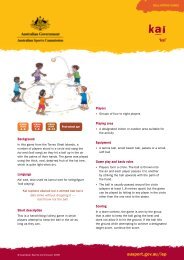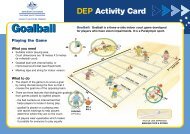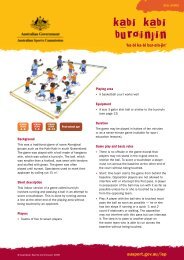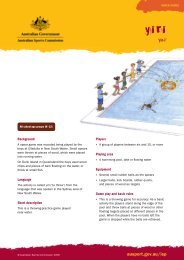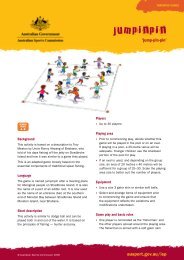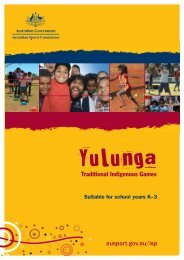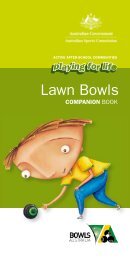the sydney 2000 olympic and paralympic games - Australian Sports ...
the sydney 2000 olympic and paralympic games - Australian Sports ...
the sydney 2000 olympic and paralympic games - Australian Sports ...
You also want an ePaper? Increase the reach of your titles
YUMPU automatically turns print PDFs into web optimized ePapers that Google loves.
PART FOUR : NSW GOVERNMENT AGENCIES GAMES SUPPORT SERVICES<br />
hospital was <strong>the</strong> preferred destination for members of <strong>the</strong> Olympic or Paralympic Family in <strong>the</strong> event of<br />
emergency. O<strong>the</strong>r metropolitan hospitals received Olympic-related patients, such as members of <strong>the</strong><br />
Olympic workforce <strong>and</strong> media.<br />
The following hospitals had a designated support role for <strong>the</strong> Paralympic Games:<br />
• Concord Repatriation Hospital was <strong>the</strong> main Paralympic Hospital providing services to <strong>the</strong> athletes<br />
<strong>and</strong> officials residing in <strong>the</strong> Paralympic Village at Sydney Olympic Park.<br />
• Westmead Hospital provided spectator services for events at Sydney Olympic Park.<br />
• Prince of Wales Hospital supported Sydney Harbour events.<br />
• Arrangements were made for specialist Spinal Cord Injury care to be provided at Prince of Wales <strong>and</strong><br />
Royal North Shore Hospitals. However, this service did not need to be utilised during <strong>the</strong> Games.<br />
Games-time results<br />
769 presentations <strong>and</strong> 184 admissions were reported during <strong>the</strong> Olympics <strong>and</strong> a fur<strong>the</strong>r 107 presentations<br />
<strong>and</strong> 44 admissions during <strong>the</strong> Paralympic period.<br />
Doping Program<br />
SOCOG <strong>and</strong> SPOC delivered a professional <strong>and</strong> efficient Doping Control Program in accordance with <strong>the</strong><br />
IOC Medical Code <strong>and</strong> <strong>the</strong> International Paralympic Committee Medical Controls Guide. The Doping<br />
Control Program included procurement of sample collection equipment <strong>and</strong> provision of advice relating to<br />
<strong>the</strong> testing requirements for competition venues.<br />
The <strong>Australian</strong> <strong>Sports</strong> Drug Agency trained approximately 450 SOCOG doping volunteers in collection<br />
methods. It also provided Commonwealth funded drug tests as part of SOCOG's test event program in <strong>the</strong><br />
lead up to <strong>the</strong> Games.<br />
The <strong>Australian</strong> <strong>Sports</strong> Drug Testing Laboratory, which is accredited by <strong>the</strong> IOC, analysed urine samples for<br />
<strong>the</strong> Games <strong>and</strong> collaborated with <strong>the</strong> <strong>Australian</strong> Institute of Sport to develop a world first blood test for<br />
erythropoietin (EPO).<br />
Food Safety Program<br />
The food safety program commenced in 1999 with “Operation Foodwatch”, a systematic audit of high<br />
volume, tourism related food outlets. A total of 5,131 outlets in <strong>the</strong> greater metropolitan area, including <strong>the</strong><br />
Central Coast, Hunter <strong>and</strong> Wollongong areas were recorded on a database. With <strong>the</strong> co-operation of local<br />
government officers <strong>and</strong> Public Health Unit Staff, <strong>the</strong>se outlets were rated in terms of <strong>the</strong>ir food safety<br />
st<strong>and</strong>ards. Those judged unsatisfactory were highlighted for fur<strong>the</strong>r attention, with <strong>the</strong> objective being to<br />
reduce <strong>the</strong> number of food outlets requiring close monitoring during <strong>the</strong> Games.<br />
The food safety program at venues was assisted by SOCOG engaging a core group of nine master<br />
caterers. These caterers were communicated to <strong>the</strong> Department of Health well before <strong>the</strong> Games,<br />
allowing close liaison to be established. Caterers were given food safety information sheets <strong>and</strong> guidance<br />
in drawing up Hazard Analysis & Critical Control Point food safety plans. In addition, ongoing liaison with<br />
OCA enabled <strong>the</strong> Department of Health to have input into <strong>the</strong> construction <strong>and</strong> fitout of food premises,<br />
including temporary structures.<br />
Games-time Results<br />
No outbreaks of food borne illness were detected during <strong>the</strong> Games. The following statistics provide an<br />
overview of Food Safety Program results:<br />
• 83 food safety officers conducted daily inspections of all food outlets at venues.<br />
• 9,000 food safety inspections of 1,066 food outlets were carried out at Olympic venues<br />
63


